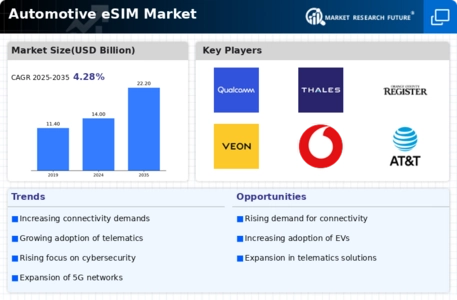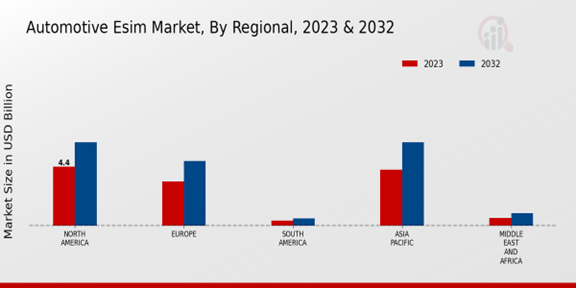Market Growth Projections
The Global Automotive eSIM Market Industry is poised for substantial growth, with projections indicating a market value of 14.0 USD Billion in 2024 and an anticipated increase to 22.2 USD Billion by 2035. This growth trajectory suggests a robust demand for eSIM technology, driven by factors such as enhanced connectivity, regulatory support, and the rise of electric vehicles. The compound annual growth rate (CAGR) of 4.28% from 2025 to 2035 reflects the increasing integration of eSIMs in automotive applications, highlighting the industry's shift towards more connected and efficient vehicle solutions.
Increased Connectivity Demand
The Global Automotive eSIM Market Industry experiences a surge in demand for enhanced connectivity solutions. As vehicles become increasingly integrated with smart technologies, the need for seamless data transmission and communication rises. This trend is evident in the growing adoption of connected car services, which are projected to reach a market value of 14.0 USD Billion in 2024. The integration of eSIM technology facilitates real-time updates, navigation, and infotainment services, thereby enhancing the overall driving experience. Furthermore, the shift towards autonomous vehicles necessitates robust connectivity, further driving the adoption of eSIMs in the automotive sector.
Emergence of Electric Vehicles
The rise of electric vehicles (EVs) presents a unique opportunity for the Global Automotive eSIM Market Industry. As EV adoption accelerates, the need for advanced connectivity solutions becomes paramount. eSIM technology supports various functionalities, including over-the-air updates, remote diagnostics, and charging station locators, which are essential for enhancing the user experience in electric vehicles. This growing segment is likely to drive significant investment in eSIM infrastructure, as manufacturers seek to differentiate their offerings in a competitive market. The increasing focus on sustainability and innovation in the automotive sector further underscores the potential for eSIM growth.
Cost Efficiency and Flexibility
The Global Automotive eSIM Market Industry benefits from the cost efficiency and flexibility offered by eSIM technology. Traditional SIM cards often require physical replacement and management, which can be cumbersome and costly for manufacturers and consumers alike. In contrast, eSIMs allow for remote provisioning and management, reducing operational costs and enhancing user convenience. This flexibility is particularly appealing to automotive manufacturers looking to streamline their production processes and improve customer satisfaction. As the market evolves, the adoption of eSIMs is likely to increase, contributing to a compound annual growth rate (CAGR) of 4.28% from 2025 to 2035.
Regulatory Support for Connectivity
Government regulations promoting vehicle connectivity significantly influence the Global Automotive eSIM Market Industry. Many countries are implementing policies that encourage the adoption of connected vehicle technologies to improve road safety and reduce emissions. For instance, regulations mandating vehicle-to-everything (V2X) communication are becoming more prevalent. This regulatory environment fosters innovation and investment in eSIM technology, as manufacturers seek to comply with these standards. As a result, the market is expected to grow, with projections indicating a value of 22.2 USD Billion by 2035, driven by the need for compliance and enhanced vehicle functionality.
Growing Demand for Telematics Services
Telematics services are becoming increasingly vital in the Global Automotive eSIM Market Industry, driven by the need for real-time data analytics and vehicle monitoring. These services enable manufacturers and fleet operators to track vehicle performance, optimize maintenance schedules, and enhance safety features. The integration of eSIM technology facilitates the seamless transmission of data, allowing for more efficient telematics solutions. As the automotive industry shifts towards data-driven decision-making, the demand for telematics services is expected to rise, further propelling the growth of the eSIM market. This trend aligns with the broader movement towards smart mobility solutions.



























Leave a Comment